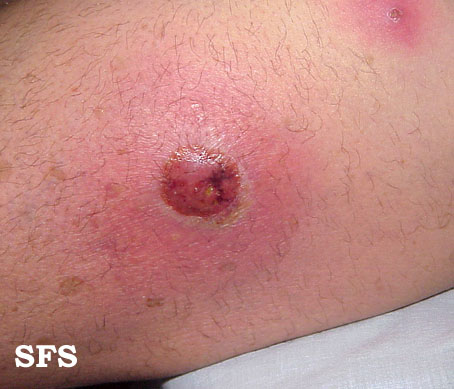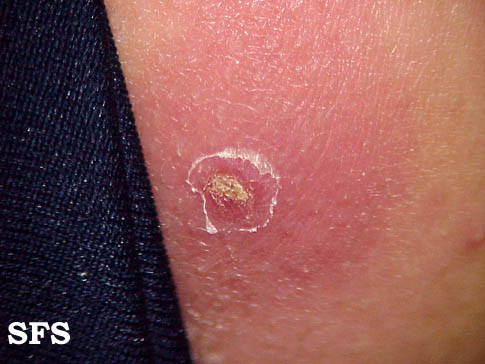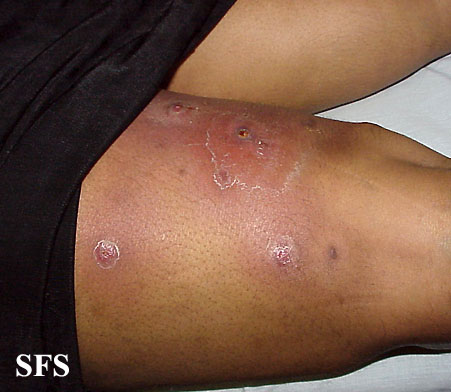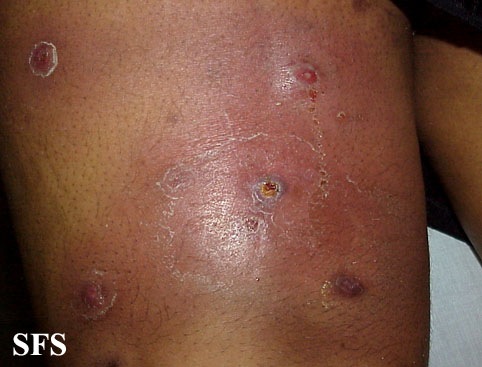Boil overview: Difference between revisions
| Line 7: | Line 7: | ||
==Historical Perspective== | ==Historical Perspective== | ||
*''[[Staphylococcus aureus]]'' was discovered in late 1870's by Alexander Ogston, a surgeon at the Aberdeen Royal Infirmary. It was the major cause of skin and soft tissue infections such as boils, scalded skin syndrome and impetigo.<ref> Methicillin resistant staphylococcus aureus. National institute of allergy and infectious diseases(2016) https://www.niaid.nih.gov/topics/antimicrobialresistance/examples/mrsa/Pages/history.aspx Accessed on August 12,2016</ref> <ref>Boil. London review of books. http://www.lrb.co.uk/v27/n24/hugh-pennington/dont-pick-your-nose accessed on August 12,2016</ref>.Carl Alois Philipp Garrè (12 December 1857, Ragaz – 6 March 1928) who was a Swiss surgeon, proved that ''[[Staphylococcus aureus]]'' causes [[carbuncles]] and [[boils]] by experimenting on himself and had one condition named after himself, Garre's [[sclerosing osteomyelitis]] (sclerosing [[osteitis]] – form of chronic [[osteomyelitis]] with proliferative [[periostitis]]).<ref name=boil(furuncle)> Wikipedia. CarlGarre(boil). https://en.wikipedia.org/wiki/Carl_Garr%C3%A9 Accessed on August 12,2016</ref> | |||
==Classification== | ==Classification== | ||
Revision as of 14:28, 12 August 2016
|
Boil Microchapters |
|
Diagnosis |
|---|
|
Treatment |
|
Case Studies |
|
Boil overview On the Web |
|
American Roentgen Ray Society Images of Boil overview |
Editor-In-Chief: C. Michael Gibson, M.S., M.D. [3]; Associate Editor(s)-in-Chief: Jesus Rosario Hernandez, M.D. [4]Yamuna Kondapally, M.B.B.S[5]
Overview
Boil or furuncle is a skin disease caused by the inflammation of hair follicles, thus resulting in the localized accumulation of pus and dead tissue. Individual boils can cluster together and form an interconnected network of boils called carbuncles. In severe cases, boils may develop to form abscesses.
Historical Perspective
- Staphylococcus aureus was discovered in late 1870's by Alexander Ogston, a surgeon at the Aberdeen Royal Infirmary. It was the major cause of skin and soft tissue infections such as boils, scalded skin syndrome and impetigo.[1] [2].Carl Alois Philipp Garrè (12 December 1857, Ragaz – 6 March 1928) who was a Swiss surgeon, proved that Staphylococcus aureus causes carbuncles and boils by experimenting on himself and had one condition named after himself, Garre's sclerosing osteomyelitis (sclerosing osteitis – form of chronic osteomyelitis with proliferative periostitis).[3]
Classification
Boil (furuncle) may be classified according to the International Classification of Diseases (ICD-10) based on anatomical location.[4]
Pathophysiology
Boil(furuncle) is a localized, deep, suppurative, necrotizing form of folliculitis which involves dermis and subcutaneous tissue. Staphylococcus aureus is the most common causative agent. Following abrasion or cut the pathogen uses the entry site to invade and colonize the hair follicle leading to the formation of tender, red, perifollicular nodule. It later becomes painful and fluctuant terminating in the discharge of pus and necrotic plug which may leave a scar.[5]
Causes
Boils(furuncles) are generally caused by an infection of the hair follicles by Staphylococcus aureus or Staphylococcus epidermidis, a strain of bacterium that normally lives on the skin surface.
Differentiating Boil overview from Other Diseases
Boil(furuncle) must be differentiated from other common diseases that cause tender swelling or a reddened lump filled with pus such as cystic acne, hydradrenitis suppurativa and pilonidal cyst.[6]
Epidemiology and Demographics
Risk Factors
Common risk factors in the development of boil(furuncle) include immunosupression, malnutrition, coexisting skin conditions and poor hygiene
Screening
Screening is not recommended for boil(furuncle).
Natural History, Complications, and Prognosis
If left untreated, patients with boil(furuncle) may progress to develop carbuncle, fever and lymphadenopathy. Most common complications of boils(furuncle) include scaring and recurrence. Other complications are septicemia leading to abscess of spinal cord, brain, kidneys or other organs. Prognosis is generally good however it varies with underlying risk factors, if left untreated.
Diagnosis
History and Symptoms
A detailed and thorough history from the patient is necessary. Specific areas of focus when obtaining a history from the patient include history of immunosupression, family history of furunculosis, history of contact sports, history of close contact and recent travel. Common symptoms of boil(furuncle) include firm red painful bump with pus filled head.
Physical Examination
Gallery
Laboratory Findings
The Laboratory study which is usually required for patients with boil(furuncle) is the pus culture.
Imaging Findings
X ray may be performed to detect internal abscess and osteomyelitis.
Other Diagnostic Studies
Other diagnostic studies of boil(furuncle) include blood analysis, urine analysis and biopsy.
Treatment
Medical Therapy
The mainstay of therapy for mild furuncles is incision and drainage only. Antimicrobial therapies are indicated in moderate and severe furuncles. Empiric antimicrobial therapies for furuncle include either TMP-SMX or Doxycycline for moderate furuncles, and either Vancomycin, Daptomycin, Linezolid, Telavancin, or Ceftaroline for severe furuncles.[7][8]
Surgery
Incision and drainage is indicated if the boil(furuncle) is deep and large and persistent despite medical therapy.[9]
Prevention
Primary prevention
Effective measures for primary prevention of boil(furuncle) include hand washing, antibacterial soaps, maintain proper hygeine(Hand sanitizers,antiseptic washes), avoid close contact(homeless shelters, military, prisons).
Secondary prevention
Secondary prevention strategies following boil(furuncle) are warm, moist, compresses on boil, hand washing and proper wound care.
References
- ↑ Methicillin resistant staphylococcus aureus. National institute of allergy and infectious diseases(2016) https://www.niaid.nih.gov/topics/antimicrobialresistance/examples/mrsa/Pages/history.aspx Accessed on August 12,2016
- ↑ Boil. London review of books. http://www.lrb.co.uk/v27/n24/hugh-pennington/dont-pick-your-nose accessed on August 12,2016
- ↑ Wikipedia. CarlGarre(boil). https://en.wikipedia.org/wiki/Carl_Garr%C3%A9 Accessed on August 12,2016
- ↑ ICD-10 Diagnosis Codes Index. http://icdlist.com/icd-10/index/cutaneous-abscess-furuncle-and-carbuncle-l02 Accessed on August 4,2016
- ↑ Ibler KS, Kromann CB (2014). "Recurrent furunculosis - challenges and management: a review". Clin Cosmet Investig Dermatol. 7: 59–64. doi:10.2147/CCID.S35302. PMC 3934592. PMID 24591845.
- ↑ Boil(furuncle)(2016).https://en.wikipedia.org/wiki/Boil Accessed on August 9, 2016.
- ↑ Gilbert, David (2015). The Sanford guide to antimicrobial therapy. Sperryville, Va: Antimicrobial Therapy. ISBN 978-1930808843.
- ↑ Boils(furuncle). MedlinePlus(2016). [1] Accessed on August 11,2016
- ↑ Boils(furuncle). MedlinePlus(2016). [2] Accessed on August 11,2016





